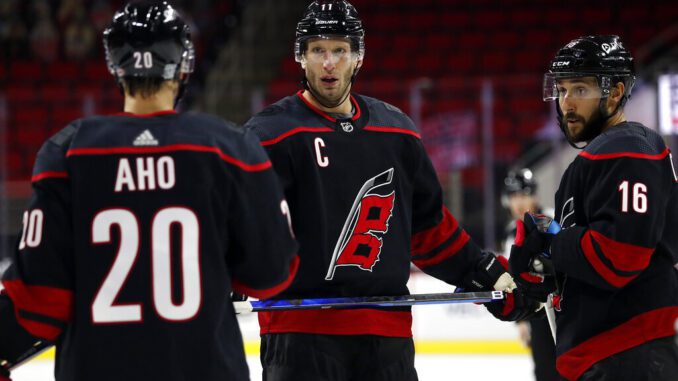
For a long time, a common template for constructing a team in the NHL was to “build from the goalie out.” The workhorse goalie who sometimes played 70 or more games over the course of the season was the cornerstone of a winning franchise, even high-scoring ones like the 1980s Oilers.
In recent years, perceptions of goaltending have changed. For one, there just aren’t many goaltenders these days that can handle the workload that Patrick Roy or Martin Brodeur once did. Secondly, two-goalie systems have become more commonplace, and while NHL teams still want the best goalies, they also want a reliable backup.
Which brings us to the other common refrain used in discussing the architecture of a team: “building down the middle.”
One look at the Carolina Hurricanes makes it clear which path the franchise chose in constructing its current roster.
The Hurricanes’ acquisition of Jordan Staal in 2012 was supposed to be a step toward this goal, with the younger Staal becoming a No. 2 center behind older brother Eric. While that never led to success, Staal has become a cornerstone player for each coach that has come through Raleigh, none more than Rod Brind’Amour.
Brind’Amour has called Staal the player that “stirs the drink” for the Hurricanes, and this season he’s added more offensive production (seven goals, eight assists in 15 games) to go with his ever-present defensive dominance.
“I’ve said this before, but it feels like he’s playing the same way,” Brind’Amour said of Staal’s play this season. “It’s just the opportunities, he’s cashing in, where in the past I’d come back after the game and go, ‘Who had the most chances or created the most,’ and his name was always on it. But there was nothing to show for it.”
While Staal’s production has slowed in recent games — coinciding with the injury to Teuvo Teravainen that led to Andrei Svechnikov being moved off Staal’s wing and onto Sebastian Aho’s — his offensive play could finally get him the recognition his defensive play has long deserved with his first Selke Trophy. He was a finalist with Pittsburgh in 2009-10, finishing third, but has never been higher than ninth (2016-17) in the voting since coming to Carolina.
“It should go to a guy who puts up points,” Brind’Amour, a two-time Selke winner himself, said. “I think it’s a two-way player, you gotta be able to do both. … I don’t think he’s really changed any of his game, but he definitely needs to be in that conversation.”
While Staal is the foundation of the Hurricanes’ center corps, Aho is the star.
The 23-year-old Finn may seem like he’s had a quiet start to the season, but he remains right near a point-per-game pace (six goals, 10 assists in 17 games) and has yet to go two consecutive games without a point.
And then there’s Vincent Trocheck, acquired by Carolina before last season’s trade deadline and on pace to have the best season of his career with nine goals and seven assists through 16 games.
“When those three are playing well, it takes stress off of each other,” Brind’Amour said. “When one is struggling or one is maybe not doing as good in certain areas, then the other one can pick the slack up.
“It’s definitely a bonus when you can have those guys going down the middle because you don’t worry as much about matchups. There’s just a whole bunch of things that, when they’re going well, it sets us up to be a really, really good team.”
The Hurricanes also recently added Cedric Paquette, the gritty forward who won a Stanley Cup last season with Tampa Bay and is capable of playing center or wing.
“He’s a blast out there to watch,” linemate Jordan Martinook said of Paquette. “He’s getting in those scrums, and I think that’s something our team needs. I think he brings that edge and that physicality that sometimes our team lacks, but he’s definitely a great addition.”
And all of the skill down the middle makes for a good learning environment for young players like Steven Lorentz, who has centered the fourth line the past few games.
“There’s things you can take away from each guy,” Lorentz said. “You’ve got some size up the middle with Jordo, and then you’ve definitely got some skill with Troch and Aho. So I just try and watch what they do in practice. … I’m just trying to watch them and see how they think the game and if there’s anything that I can take away from the practices and the games and apply it myself.”
All of that equals a team, build down the middle, that can go places.
“Depth is what wins championships,” Trocheck said. “So I think right now, the way that we’re going, getting contributions from all four lines, it’s definitely a big factor in the way we’re playing and a big factor in winning games.
“Centers down the middle is extremely important.”



